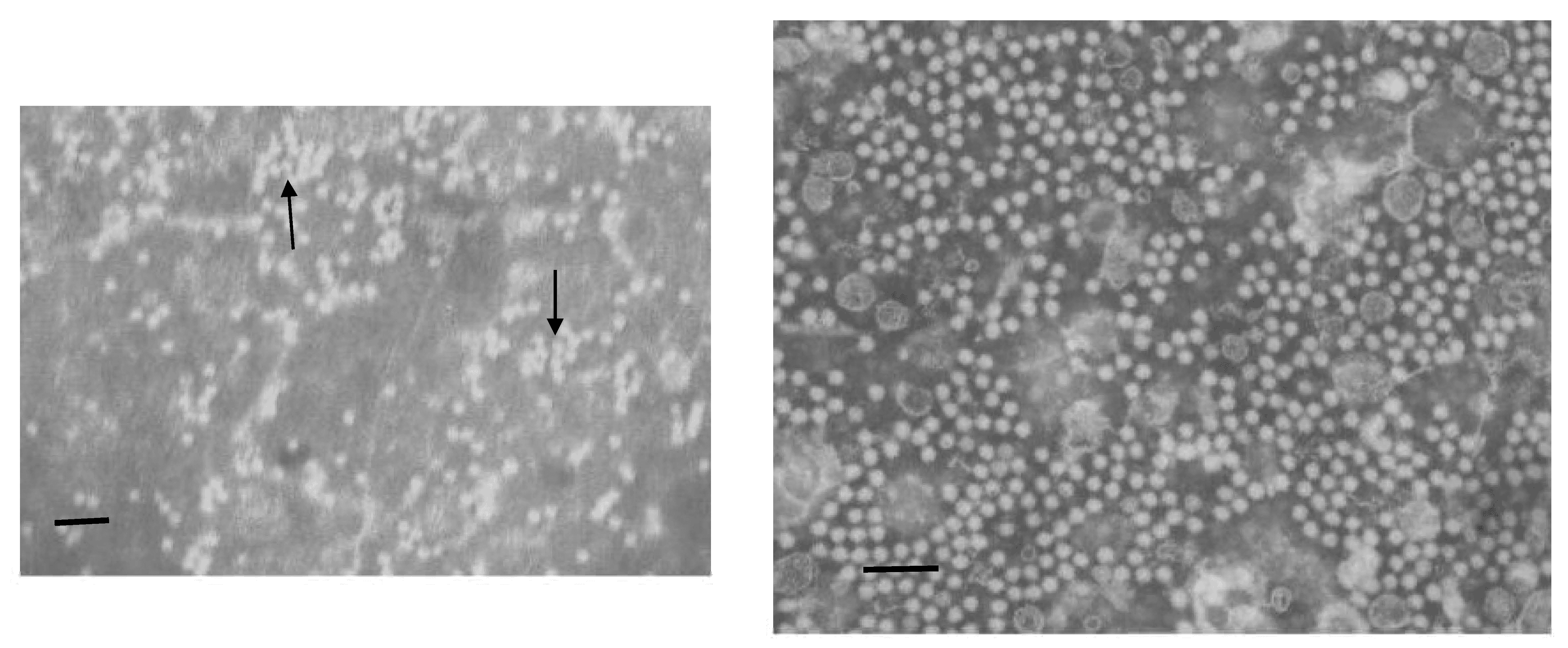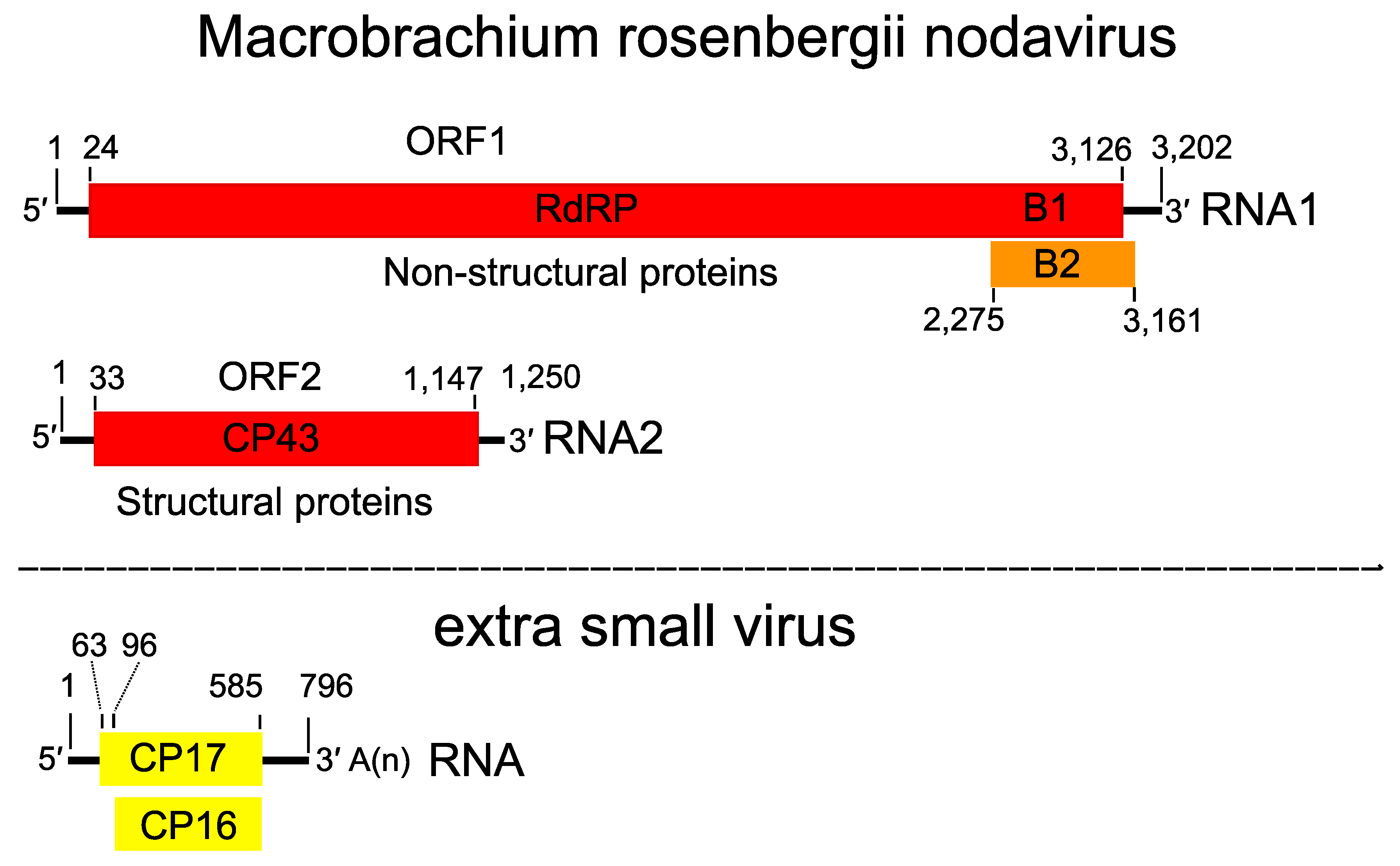Family: Sarthroviridae
A. S. Sahul Hameed, A. S. Ninawe, T. Nakai, S. C. Chi and K. L. Johnson
Corresponding author: Sahul Hameed, A.S. (cah_sahul@hotmail.com)
Edited by: Nick J. Knowles and Stuart G. Siddell
Posted: September 2018
PDF: ICTV_Sarthroviridae.pdf
Summary
Extra small virus (XSV) is a satellite virus of Macrobrachium rosenbergii nodavirus (MrNV), an unclassified virus related to members of the family Nodaviridae (Bonami et al., 2005) (Table 1. Sarthroviridae). Both viruses have isometric, spherical virions (Figure 1. .Sarthroviridae), infect giant fresh water prawns, and together cause white tail disease, which is responsible for mass mortalities and important economic losses in hatcheries and farms (Bonami and Sri Widada 2011). XSV replication is dependent on that of MrNV and the two viruses are always found together (Bonami and Sri Widada 2011, Zhang et al., 2006).
Table 1. Sarthroviridae. Characteristics of members of the family Sarthroviridae.
| Characteristic | Description |
| Typical member: | extra small virus (AY247793), species Macronovirus macrobrachii |
| Virion | Spherical, about 15 nm in diameter |
| Genome | Linear positive-sense ssRNA with a 3′-poly(A) tail |
| Replication | Dependent on co-infection with Macrobrachium rosenbergii nodavirus |
| Translation | A single ORF is translated into two capsid proteins, one an N-terminally truncated version of the other |
| Host range | Giant fresh water prawns |
| Taxonomy | Realm Riboviria; order Tombendovirales; one genus with a single species |
Virion
Morphology
XSV virions are non-enveloped, spherical, about 15 nm in diameter and serologically unrelated to those of MrNV. They have icosahedral symmetry (Longyant et al., 2012, Qian et al., 2003).
 |
| Figure 1. Sarthroviridae. Transmission electron micrographs of negatively-stained (left) extra small virus (bar = 50 nm) and (right) Macrobrachium rosenbergii nodavirus (bar = 100 nm) virions purified by differential ultracentrifugation. |
Physicochemical and physical properties
XSV virions have a density of 1.325 g mL-1 in 25–40% CsCl gradients. Viruses are inactivated at 50 °C for 10 minutes but stable to pH between 2 and 8.
Nucleic acid
The XSV genome is a linear positive-sense RNA molecule of 796 nucleotides which, unlike other satellite viruses, contains a short poly(A) tail of 15–20 nucleotides at the 3′-end (Widada and Bonami 2004) (Figure 2. .Sarthroviridae).
Proteins
Protein analysis by SDS-PAGE showed that the protein composition of XSV is simple and composed of two polypeptides of about 17 and 16 kDa which are the major protein components that form the viral capsid.
Lipids
None
Carbohydrates
None
Genome organization and replication
The positive-sense genome contains a single open reading frame from which two capsid proteins are independently translated from different initiation codons. These capsid proteins, CP17 (17 kDa) and CP16 (16 kDa), are present in nearly equimolar amounts in the virion (Widada and Bonami 2004, Wang et al., 2008). It has been reported that the 3′-untranslated region plays an important role in selective encapsidation of the XSV genome (Liang et al., 2014). The capsid proteins are not recognizably similar to proteins in the public sequence databases (Widada and Bonami 2004). Replication is dependent upon the RNA-dependent RNA polymerase of the helper virus MrNV.
 |
| Figure 2. Sarthroviridae. Genome organization of the Macrobrachium rosenbergii nodavirus and extra small virus genomes. RdRP: RNA-dependent RNA polymerase, CP: capsid protein. Numbers indicate nucleotide positions. |
Biology
XSV and MrNV have been detected in aquatic insects of several species, which were collected from nursery ponds containing freshwater prawn (Macrobrachium rosenbergii) infected with MrNV and XSV (Sudhakaran et al., 2008a). Both viruses could also replicate in mosquito cell lines, suggesting that aquatic insects serve as vectors for the transfer of XSV and MrNV (Sudhakaran et al., 2008a).
Antigenicity
XSV virions are serologically unrelated to those of MrNV (Longyant et al., 2012, Qian et al., 2003).
Derivation of names
Sarthro from small arthropod.
Macronovirus from Macrobrachium rosenbergii the host species, and nodavirus, the group of viruses to which the helper virus Macrobrachium rosenbergii nodavirus is most closely related.
Relationships within the family
Several XSV isolates from geographically remote locations, including French West Indies, Thailand, Taiwan, China and India, have been reported (Bonami and Sri Widada 2011, Sudhakaran et al., 2008b). The isolates display 96–99% nucleotide identity in their capsid protein genes (Sudhakaran et al., 2008b).
Relationships with other taxa
The capsid protein is not recognizably similar to proteins in the public sequence databases (Widada and Bonami 2004).

